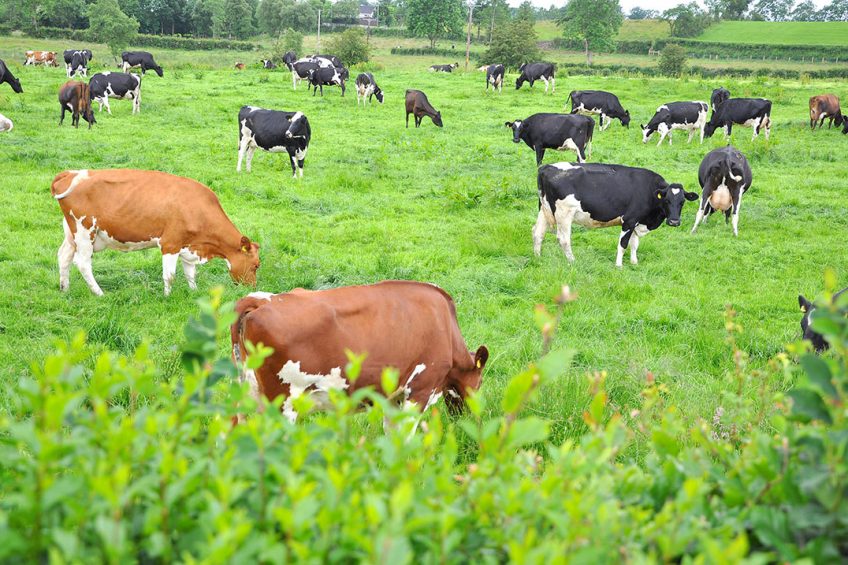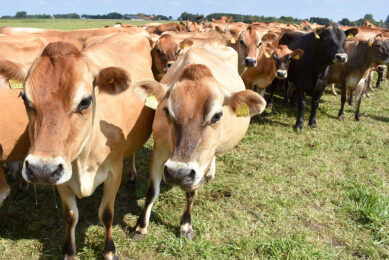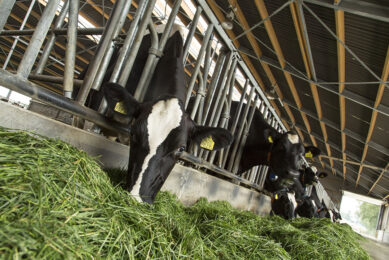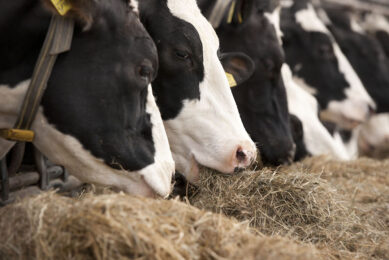Maximise use of grazed grass for dairy cattle

Dairy farmers now, more than ever, must ensure they maximise the use of every square inch of grazed grass to help produce milk at a lower cost.
In general the utilisation of grazed grass is not as good as it could be. Results from trials conducted on farm in Northern Ireland by AFBI (Agri-Food and Biosciences Institute) shows that 12.2 tonnes of grass dry matter (DM) per hectare can be grown on average but only 7.5 tonnes is utilised. In order to help farmers maximise the use of grazed grass AFBI has issued some guidelines to try and reduce the cost of milk production.
Grass growth and cover
The ideal pre-grazing grass cover for dairy cows in a rotational grazing system (paddocks or strip-grazing) is 3,000 kg DM/hectare. This is equivalent to a grass height of 8-10cm and can sustain a high level of milk production with good compositional quality. The sward recovery is also quicker than when heavier grass covers are grazed. Paddocks should be grazed down to around 1,600 kg DM/hectare or 4cm.
Grass quality
With grass growth and weather conditions changeable, it is essential farmers walk the grazing platform at least once a week, either by eyeballing or using a plate meter. This is the only sure way to assess the quality and quantity of grass in front of the herd.
Grass management
Surplus grass can be removed as silage and it is important that this is cut at an early stage even though it is a light crop. This will ensure a leafy regrowth is available for grazing as soon as possible. During periods of grass shortage, cows may be fed additional concentrates or buffer fed silage, until grass is in sufficient supply.
Consider batching cows
In a spread calving pattern herd AFBI urges farmers to consider batching cows using their milk yield as a parameter.
Groups could be:
- Grazing full time – Moderate yielding cows confirmed in calf and late lactation cows.
- Grazing by day and housed at night – Mid lactation cows and those producing up to 30 litres.
- Housed full time, if practised by your particular system – Freshly calved and highest yielding cows.
For block calving cows, in either spring or autumn, the herd can be managed as one block for ease of management either for fulltime grazing or grazed by day and housed at night.
Milk from grass
Grass is a quarter of the cost of concentrates per kilogram of dry matter (kgDM) therefore it makes sense to increase intake of grazed grass for the dairy herd. High quality Spring grazed grass, if managed correctly, is capable of supporting maintenance plus 20 litres of milk.
To calculate the amount of milk produced from grazed grass for a dairy cow, establish the concentrates fed in kg, divide by 0.45, to give the milk produced from concentrates and then subtract from the total daily milk yield.
For example, a cow producing 35 litres and fed 10kg of concentrates is 10 divided by 0.45 giving 22 litres from concentrates, consequently 35 litres minus 22 litres gives 13 litres from grazed grass. This highlights that this cow is not producing enough from grazed grass and has a higher cost of milk production.
Energy and protein content of diet
Energy, not protein or minerals, is the most limiting nutrient in the dairy cow. If cows are not milking as well as expected, or milk protein is low, or cows are losing excessive condition, energy is the first nutrient to check.
Farmers should check the total dry matter intake of the animal as well as the quality (i.e. energy content) of the concentrates used.
Spring grass has a higher protein content at 20% than average quality silage at 12%, consequently cows should be fed a lower protein concentrate at grass, 15% to 18% protein on a fresh weight basis.
When should feed high protein diets be avoided?
High protein in the diet can result in excessive body weight loss as the cow metabolises the extra protein. Avoid feeding high protein diets during the breeding season to reduce the risk of embryonic loss and poor fertility performance. Dietary protein levels can be monitored through milk urea testing and the optimal is between 20 and 35 mg/100ml.
Lower milk butterfat
In early season, grass is leafy and has a low fibre content and milk butterfat may fall. Cows should be fed a fibre based (sugar beet, soya hulls, citrus pulp) concentrate. This is to reduce the risk of digestive upsets and will help to maintain milk butterfat percentage.
In certain situations it may be necessary to include an acid-buff in the diet to reduce the risk of rumen upsets. As the grazing season progresses, grass quality deteriorates and feeding a cereal based concentrate may be more beneficial.

Managing high grass cover
Even the best grassland managers can have grazing swards which become too long for quality grazing, over 3,000kg DM/ha, therefore farmers need to consider improving grass utilisation.
These options can be used:
- Pre-mowing – weather permitting, cut the grass a day prior to grazing and let the cows pick up the wilted forage from the swathe. Best results are achieved when the grass is cut by a disc mower without a conditioner. This will ensure better grass utilisation and also a high quality regrowth.
- Leader/Follower – this enables higher yielding cows to achieve higher grass intakes and milk yields by allowing the cows to eat the leafy portion of the sward. The stem residue can then be grazed down quickly with other stock, e.g. heifers or dry cows.
- Topping – After the second grazing rotation, paddocks should be topped if there is an accumulation of stemmy material and poor quality grass around dung pats. This will improve the quality of the regrowth and subsequent grazings. Set the topper to cut grass at 5-6cm height. Topping should be carried out immediately after cows are removed from a grazing area as a later topping will check the regrowth. Research has shown that topped swards will improve yield by 1.2 litres/ cow per day in mid to late season, compared to swards that were not topped.
- Alternate grazing & cutting – Cutting all grazing paddocks at least once during the season leaves a clean sward with an even regrowth and may improve grass utilisation and cow performance later in the season.
Flexible grazing management
During periods of wet weather adopt a flexible approach. This may involve on/ off grazing, allowing cows to graze for a few hours after milking and fed silage when housed. The aim being to keep up grass intake, manage swards and avoid damage to grassland.











